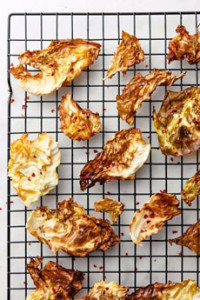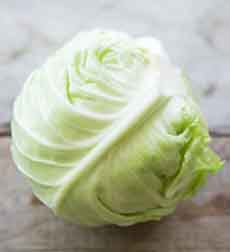RECIPE: Baked Cabbage Chips
|
We over-kaled last year. We couldn’t escape it: It seemed as if every restaurant entrée we ordered came with kale. We made too many kale chips as “better for you” snacks. Now we’re on a kale moratorium, and were happy to discover that you can also make chips from kale’s cruciferous cousin, cabbage. The recipe is from our favorite gourmet grocer, Good Eggs in San Francisco. RECIPE: CABBAGE CHIPS Ingredients 1. PREHEAT the oven to 225°F. Line two baking sheets with wire racks; parchment is fine if you don’t have racks. 2. CUT the cabbage into quarters and discard the tough outermost leaves. Carefully remove the innermost leaves and spread them on the baking sheets/racks in a single layer. 3. DRIZZLE or brush the leaves lightly with olive oil and use a brush (or your fingers) to spread the oil over the front and back of each leaf. 4. BAKE for about 90 minutes, until the cabbage is crispy and golden brown. Remove from the oven and season with salt and chile flakes. Eat immediately or store in the fridge in an airtight container. 5. MAKE the optional yogurt dip. Blend nonfat Greek yogurt with dill, optional minced garlic and salt to taste. Or, substitute curry powder for the dill. |

|
|
|
THE CRUCIFEROUS VEGETABLES FAMILY Your healthcare providers want you to eat more cruciferous veggies. Cruciferous vegetables—also known as brassicas—are superfoods that comprise the Brassicaceae family of vegetables. These nutritional powerhouses are also packed with cancer-fighting* phytonutrients, powerful antioxidants. The family includes arugula, bok choy, broccoli, Brussels sprouts, cabbage, cauliflower, collard greens, horseradish, kale, kohlrabi, mizuna, mustard greens, radish, rapeseed/canola, rapini (broccoli rabe), rutabaga, tatsoi and turnips. Eat up: They’re low in calories and high in fiber, vitamins and minerals. Consume them raw or lightly steamed to get the maximum amount of antioxidants. Just don’t overcook them! You can eat overcooked carrots or potatoes; overcooked broccoli and Brussels sprouts are not so pleasant. “Cruciferous” derives from cruciferae, New Latin for “cross-bearing.” It is so named because the flowers of these vegetables consist of four petals in the shape of a cross. Here’s a book you may enjoy: Brassicas: Cooking the World’s Healthiest Vegetables: Kale, Cauliflower, Broccoli, Brussels Sprouts and More. |
||



